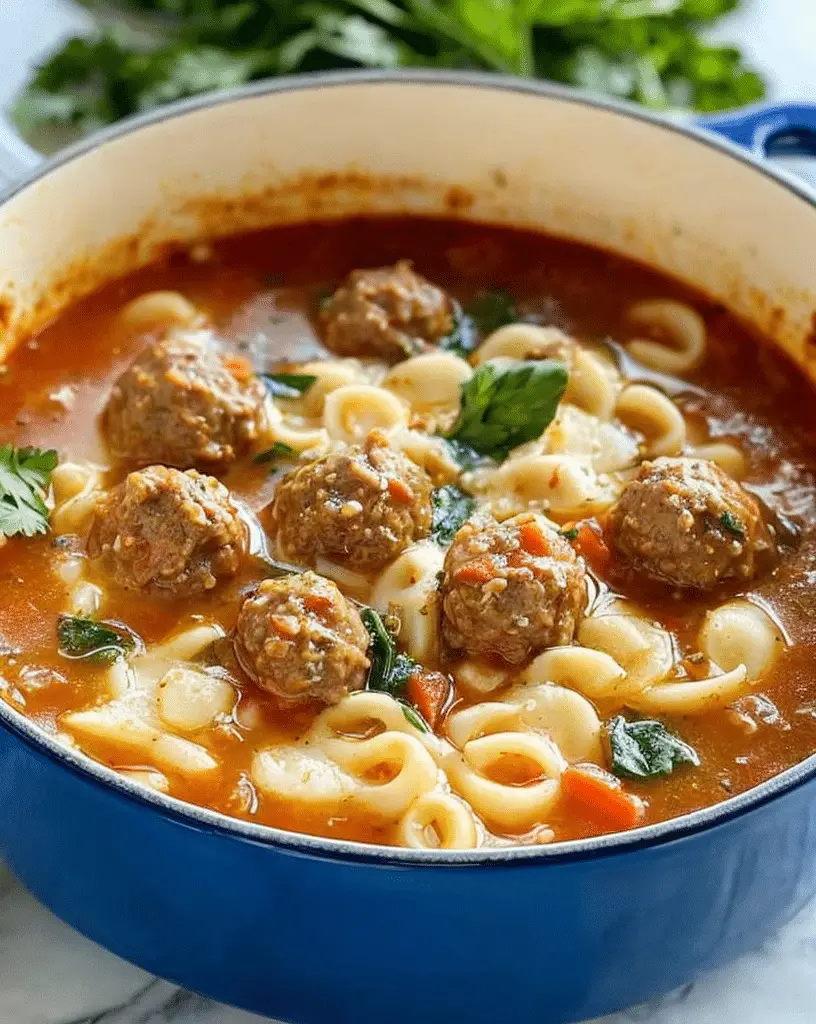Hearty Meatball Soup with Vegetables: A Bowl of Comfort and Flavor
Nothing warms you up quite like a hearty meatball soup with vegetables. This nourishing dish is the perfect blend of tender meatballs, delicious vegetables, and savory broth. Whether you’re preparing a comforting weeknight dinner or hosting a cozy gathering, this soup will elevate the occasion. Each spoonful delivers a delightful array of flavors, with herbs and spices weaving a tapestry of taste that will have you coming back for more.
The hearty meatball soup with vegetables promises not just great taste but also a delightful texture. The vegetable medley includes carrots, potatoes, and celery, giving the soup a satisfying crunch that complements the soft, juicy meatballs. This well-balanced combination will please the palate and provide a nutritious feast for all those gathered around your table.
Quick Recipe Highlights
Flavor Profile: The soup boasts a deep, savory taste, accentuated by aromatic herbs and spices. The broth is rich, offering a comforting warmth that perfectly pairs with the seasoned meatballs and fresh vegetables.
Texture: Experience the soft, tender meatballs contrasted with the crunchy, fresh vegetables, all soaked in a sumptuous broth. It’s a harmonious blend that promises consistent enjoyment with every bite.
Aroma: As it simmers, an enticing aroma of herbs, hearty meat, and fresh vegetables fills the kitchen, creating an inviting atmosphere that heightens the anticipation of this delectable soup.
Visual Appeal: The vibrant colors of carrots, celery, and potatoes nestled amongst the meatballs in the rich broth make for an eye-catching presentation that’s as appealing to look at as it is to eat.
Skill Level Needed: This recipe is straightforward, requiring only basic cooking skills, making it accessible even to beginners. With clear instructions, it ensures a successful preparation.
Special Equipment: A large soup pot or Dutch oven ensures even cooking and sufficient space for all ingredients, allowing the flavors to meld perfectly together.
Recipe Overview
Difficulty Level: This dish is easy to prepare, perfect for novices and seasoned cooks alike. The straightforward cooking process involves forming the meatballs and simmering everything in a single pot.
Category: This soup falls under the categories of dinner and comfort food, suitable for family meals, casual gatherings, or as a quick, nourishing meal any day of the week.
Cuisine: While it draws influences from Italian and American kitchens, this soup blends savory elements from various culinary traditions, offering universal appeal.
Cost: With simple, accessible ingredients, this soup is budget-friendly, making it a great addition to your weekly meal plans without straining your wallet.
Season: Perfect for colder months, this warm, hearty soup soothes on chilly evenings. However, with fresh vegetables, it’s also delightful year-round.
Occasion: Ideal for family dinners, casual get-togethers, and meal prepping, this versatile recipe fits various occasions. Its comforting nature makes it a go-to for cozy winter nights.
Why You’ll Love This Recipe
Taste and texture appeal: The hearty meatball soup with vegetables provides a delightful symphony of flavors and textures. The tender, juicy meatballs, mixed with fresh, colorful vegetables, create a sensory delight in every spoonful. The rich broth ties everything together, delivering a satisfying culinary experience that is both nourishing and comforting.
Convenience and preparation benefits: This recipe is a one-pot wonder, simplifying both the cooking and clean-up process. With its straightforward preparation, it’s a great choice for busy weeknights when you crave a homemade meal without the hassle. Plus, it can be made in advance, allowing you to enjoy a wholesome meal with minimal effort.
Nutritional advantages: Packed with protein, vitamins, and minerals, this soup is a nutritious addition to your diet. The meatballs provide a rich source of protein, while the vegetables offer essential vitamins and fiber, making this a balanced meal that supports your health and well-being.
Social and entertaining value: Whether you’re gathering with family or hosting friends, this soup is a crowd-pleaser that brings people together around the table. Its inviting aroma and hearty flavors make it a memorable dish that will surely leave a lasting impression on your guests.
Cost-effectiveness and accessibility: With affordable ingredients readily available at your local grocery store, this recipe is a budget-friendly option that doesn’t compromise on flavor or quality. It’s an excellent way to feed a crowd without breaking the bank, making it a smart choice for families and budget-conscious cooks.
Historical Background and Cultural Significance
Origin story: The beloved meatball soup has roots in Italian cuisine, where frugality and bold flavors combined to create nourishing meals. Traditionally prepared in nonna’s kitchen, this soup represented resourcefulness, using meat scraps and fresh garden vegetables to craft a filling dish.
Cultural importance: Often a staple in Italian-American households, this soup embodies the warmth and hospitality of family traditions. It has become synonymous with comfort food, providing solace during cold seasons and community gatherings.
Evolution of the recipe: Over time, the recipe evolved to incorporate different regional ingredients, adapting to varied tastes and preferences while preserving its essence—a flavorful, filling meal that feeds the body and soul.
Regional variations: Different regions have adapted meatball soup to reflect local palates. While the Italian version features herbs like oregano and basil, some cultures introduce spices such as cumin or coriander to complement the hearty broth.
Ingredient Deep Dive
Ground beef: Essential for the meatballs, ground beef brings cultural significance and versatile flavor profiles. It’s a budget-friendly protein source, rich in iron and zinc, promoting health when consumed in moderation. Choose beef with balanced fat content for juicy, tender meatballs, and store it refrigerated for freshness.
Vegetables: Carrots, potatoes, and celery infuse the soup with color and nutrition. High in vitamins A and C, they support immunity and enhance the flavor profile. When selecting, pick firm, bright vegetables, and store them in a cool, dry place to maintain crispness.
Broth: A key component providing depth, the broth is traditionally homemade for rich flavor, but quality store-bought versions work well too. Opt for low-sodium variants to control seasoning and keep the soup healthy.
Herbs and spices: Herbs like thyme, oregano, and parsley add aromatic flourish and health benefits like antioxidant properties. Fresh herbs impart brightness, while dried versions offer concentrated flavor—choose based on your taste and availability.
Common Mistakes to Avoid
Overcrowding the pan: When browning meatballs, spacing is key to achieving a rich crust. Allow room for even cooking, preventing steaming, and instead brown the meatballs for depth of flavor.
Ignoring seasoning: Underseasoning leads to bland soup. Taste frequently, adjusting salt and spices as needed to enhance the dish while maintaining balance.
Skipping browning step: Browning meatballs before adding them to the soup develops flavor and texture—don’t skip this step for optimal results.
Using low-quality broth: The broth is the soul of this dish. Select a good-quality broth to provide a strong flavor base, elevating the entire soup.
Rushing the simmer: Slow cooking allows flavors to meld. Give the soup time to develop complexity and richness for full-flavored enjoyment.
Not chopping vegetables evenly: Consistent vegetable sizes ensure even cooking and a pleasing presentation, contributing to the overall dining experience.
Overcooking ingredients: Avoid mushy textures by monitoring cooking times, especially for vegetables that should retain some bite for contrast against the tender meatballs.
Neglecting garnish: Fresh herbs or parmesan cheese garnish add final flavor blossoms, enhancing appearance while offering extra taste dimensions.
Essential Techniques
Browning meatballs: Improve flavor by searing meatballs until brown, using high heat and ample pan space. Monitor closely for even color, indicating caramelization and flavor development.
Simmering the broth: A gentle simmer avoids clouding and overcooking. Aim for small, occasional bubbles breaking on the surface to agitate ingredients just enough to marry flavors.
Chopping vegetables: Uniform cuts ensure even cooking. Dice vegetables equally for cohesive mouthfeel and consistent texture, providing a balanced experience throughout the soup.
Pro Tips for Perfect Hearty Meatball Soup
Use fresh breadcrumbs: Fresh breadcrumbs help bind the meatballs, preventing them from falling apart, and absorb flavors without excessive heaviness. Keep them light and avoid packing too densely.
Boost broth flavors: Integrate depth with umami-rich additions like a dash of soy sauce or a splash of Worcester sauce to bring the broth to life.
Layer herbs wisely: Use fresh herbs for garnishing at the final step, preserving vibrant flavor and a touch of freshness.
Taste as you go: Regular tasting allows subtle flavor adjustments, ensuring a well-seasoned final dish that pleases all diners.
Cook meatballs gently: Overcooking meatballs leads to toughness. Instead, simmer gently for tender meat that melts in your mouth.
Variations and Adaptations
Regional variations: Adapt the recipe with local spices or herbs to add variety. For instance, Mediterranean influences introduce rosemary and lemon zest for a citrusy twist.
Seasonal adaptations: Incorporate seasonal vegetables like zucchini in summer or butternut squash in autumn for freshness and added nutrients.
Dietary modifications: Swap beef for turkey or chicken for a leaner version or adjust to plant-based proteins for a vegetarian soup using lentils and hearty grains.
Flavor variations: Spice it up with red pepper flakes or smoked paprika for a fiery undercurrent, altering the soup to match personal taste preferences.
Texture modifications: Thicken soup by adding blended potatoes or starches, or create lightness by adding par-boiled noodles or rice for extra body.
Presentation alternatives: Serve in rustic bowls and top with freshly grated parmesan for a traditional touch or garnish with microgreens for modern flair and herbaceous depth.
Serving and Presentation Guide
Plating techniques: Dish out soup in deep, wide bowls for optimal enjoyment, revealing colorful vegetables and meatballs swimming in rich broth.
Garnishing ideas: Freshly chopped herbs like parsley add pop and fragrance, elevating soup visually and aromatically for a refined finish.
Traditional accompaniments: Serve with rustic bread or garlic toasts for a classic pairing that complements and enhances the richness of the soup.
Modern serving suggestions: Use toasted seeds or nuts to provide contrast and a crunchy element, surprising guests with unique, textural variety.
Temperature considerations: Ensure soup is served hot, retaining its intended comforting warmth, but avoid overly boiling on the stove before serving to protect delicate flavors.
Portion control tips: Offer moderate servings to keep appetite wanting more, enabling diners space for enjoying other accompanying dishes without overfilling.
Wine and Beverage Pairing
Wine pairings: Choose a medium-bodied red wine like Chianti or Merlot, which harmonizes with the rich flavors of the soup, providing a well-rounded, savory finish.
Non-alcoholic alternatives: Opt for sparkling water with lemon or iced herbal tea for refreshing, palate-cleansing contrast to the hearty dish.
Coffee/tea pairings: Serve with robust coffee post-meal or chamomile tea to end gently, complementing the herbs in the soup.
Temperature considerations: Serve beverages slightly chilled for refreshing contrast or warm for complementary comfort akin to the warm soup.
Serving suggestions: Offer chilled wine in stylish goblets or mugs for coffee, balancing style with the rustic aesthetic of the hearty soup.
Storage and Shelf Life
Storage methods: Store soup in airtight containers in the refrigerator to maximize freshness, preventing air exposure that can lead to spoilage or off-flavors.
Temperature requirements: Cool soup fully before refrigerating, promoting safe, even temperature distribution and maintaining its quality.
Container recommendations: Use glass or BPA-free plastic containers with secure lids to preserve flavors and avoid absorbent materials that can alter taste.
Signs of spoilage: Look for changes in color, unpleasant odor, or surface mold as indicators that the soup is no longer safe to consume and should be discarded.
Reheating instructions: Reheat gently over low heat, stirring occasionally to avoid ingredient separation or overcooking for best palatability.
Freezing guidelines: Freeze soup in portions, allowing room for expansion. Avoid overfilling and opt for leak-proof containers or freezer bags.
Make Ahead Strategies
Prep timeline: Prepare meatballs ahead and refrigerate, making day-of cooking simplified and less time-consuming while maintaining freshness.
Quality impact assessment: Refrigerating soup post-cooking enhances flavor melding, developing depth and complexity for even greater taste upon serving.
Assembly tips: Assemble all elements in advance, keeping components separate until final cooking to ensure peak textures and avoid sogginess.
Reheating guidelines: Allow soup to defrost in the refrigerator overnight before gentle reheating to maintain consistency without spoilage risk.
Fresh element additions: Stir in fresh herbs or a splash of lemon juice before serving for a bright, lifted finish boosting naturally mellowed flavors.
Scaling Instructions
Halving the recipe: Adjust quantities accordingly, banking on fewer ingredients while preserving space for liquid and accommodating vessel size without diminishing results.
Doubling or tripling: Scale up without skimping on liquid ratios, ensuring balance remains. Attention to meatball quantities ensures consistent distribution.
Equipment adjustments: Use larger pots proportionally with increased quantities, maintaining adequate room for even heat distribution and optimal cooking.
Timing modifications: Account for slightly longer simmer times on larger batches to guarantee even ingredient cooking and retained texture.
Storage considerations: Freeze extras for future meals, calculated in portions based on likely consumption for effective preservation and ease of use.
Nutritional Deep Dive
Macro breakdown: Rich in protein from meatballs, carbohydrates from vegetables, and balanced fats, this soup fuels energy while providing varied nutrients.
Micronutrient analysis: High in vitamins A and C, alongside iron and fiber, supporting immunity and digestion, promoting overall health through mindful ingredient combinations.
Health benefits: Opportunity for healthy living—protein promotes growth, vitamins enhance recovery, and essential fibers aid in digestive health.
Dietary considerations: Optionally low sodium with careful ingredient choices, adaptable to meet various health needs without sacrificing flavor.
Portion analysis: Serve measured portions, guided by nutritional needs to meet dietary plans, ensuring balance and awareness of calorie intake.
Weight management tips: Opt for lean meat options and integrate vegetables generously, offering filling satisfaction with minimal calorie offset.
Dietary Adaptations
Gluten-free: Ensure breadcrumbs are gluten-free and use cornstarch or arrowroot as thickeners to adjust soup within dietary boundaries.
Dairy-free: Avoid dairy-based additions in favor of vegan alternatives or adjust simply by omitting cheese garnishes.
Vegan: Substitute meat with plant-based proteins like lentils or chickpeas, preserving hearty essence while adhering to vegan principles.
Low-carb: Integrate fewer starchy vegetables, focusing on leafy greens for a low carbohydrate option without compromising vitality.
Keto: Maximize fats through avocado oil and reduce carbohydrates significantly, adjusting macros to fit ketogenic requirements.
Paleo: Adhere closely to whole ingredients and natural sources, ensuring alignment with paleolithic dietary standards and adaptations.
Low-FODMAP: Choose FODMAP-friendly vegetables like spinach and reduce onion and garlic, crafting comfort within digestive sensitivities.
Troubleshooting Guide
Texture issues: For overly thick soup, add broth to correct consistency. If too thin, cook longer or blend vegetables smoothly for natural thickening.
Flavor balance: Adjust acidity with lemon or vinegar to brighten or add more herbs for depth. Too salty? Incorporate potatoes to absorb excess.
Temperature problems: Avoid overheating, which risks flavor loss. Keep in tight control for balance between warmth and preservation of texture.
Equipment challenges: Size pots proportionately to ingredient volumes, preventing overcrowding and uneven cooking.
Ingredient substitutions: Embrace creativity cautiously—choose substitutes that uphold cauldron harmony, honoring taste and texture while meeting dietary changes.
Timing concerns: Be patient, as flavors need time to develop. Resist rushing simmering stages, which elevate and enhance final presentation.
Recipe Success Stories
Community feedback: Enthusiastic reviews applaud how delightful and straightforward meatball soup is, calling it the ideal comfort bowl cherished for cold nights.
Variation successes: From turkey meatballs to lentil adaptations, creative spins have been celebrated, maintaining authenticity while embracing novelty.
Adaptation stories: As inspiration, readers have shared swaps like gluten-free breadcrumbs and low-fat substitutions that respect dietary diversities.
Reader suggestions: Suggestions like adding kale or spinach enabled increased nutrition without altering core flavor, inspiring others to experiment boldly.
Photography tips: Capture dish beauty by accentuating texture and color contrasts, utilizing natural light for showcasing vibrant warmth and resemblance.
Frequently Asked Questions
Poultry like turkey or chicken offers a lighter option while plant-based proteins like lentils suit vegetarian adaptions effectively.
How can I make the soup spicier?
Incorporate a pinch of red pepper flakes or a chopped jalapeño for heat escalation, tailoring spiciness to fit desired tolerance.
Can I use canned vegetables in this recipe?
Fresh offers optimal flavor and texture; yet, canned can do in a pinch—adjust seasoning after tasting, accounting for brine effects.
What type of broth should I use?
Choose low-sodium chicken or vegetable broth, allowing seasoning freedom and achieving better control over diet and taste demands.
How can I thicken the soup?
Blend a portion of the soup or add potato starch for natural thickening without altering the intended broth balance.
Can this soup be frozen?
Yes, portion-friendly freezing promotes convenience and ready accessibility; defrost thoroughly for quality retention before reheating.
What’s the best way to serve this soup?
Serve piping hot, with fresh bread or salad accompaniment, garnished with fresh herbs for visual and taste enhancement.
How do I ensure the meatballs don’t fall apart?
Use binding agents like eggs and breadcrumbs while carefully forming tightly compacted, equally-sized meatballs.
Can I add pasta or rice?
Certainly! Incorporate cooked varieties toward the end to prevent absorption of excessive broth, ensuring just-right texture.
What herbs work best here?
Parsley delivers freshness, thyme enriches depth, and bay leaves provide robustness—an integrative herb array contributes to delight.
How do I store leftovers properly?
Cool and refrigerate in airtight containers, maintaining tight seals for utmost quality; ensure adequate heating upon reuse.
How can I make this recipe vegan?
Remove meat, opting for vegetable-centric focus with legumes or grains, ensuring alignment with plant-based principles.
Additional Resources
Related recipes: Try adapting this recipe into various seasonal styles, including summer gazpacho or hearty winter chili, to expand culinary horizons.
Technique guides: Explore workshops on mastering soup preparation techniques, from simmering to seasoning, honing skills, and elevating results.
Ingredient information: Visit our ingredient library to learn nutrition facts and flavor profiles, enhancing understanding for conscientious selection.
Equipment recommendations: Peruse our curated list of kitchen essentials, ensuring you’re equipped for successful meal preparations and pleasant cooking encounters.
Seasonal variations: Stay updated with seasonal arrays and ingredient swaps based on harvests and trends, encouraging culinary experimentation all year round.




